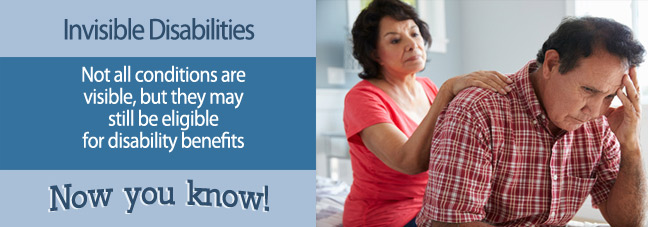If you suffer from a disability that makes it so you are unable to work, you may be eligible for disability benefits. These benefit payments can help you pay for your medical bills and everyday living expenses.
Disability benefits are offered through the Social Security Administration (SSA), and you must be medically and financially eligible in order to receive them.
But how can you apply for disability benefits if your disability is not visually apparent or obvious?
Invisible Disabilities
Most disabilities are listed in the Blue Book, which is a comprehensive list of disabling conditions put together by the SSA. The Blue Book also includes guidelines for each condition to determine who is eligible for disability benefits and who is not.
An invisible disability, or hidden disability, is a condition that is not immediately apparent.
These conditions are often not listed in the Blue Book and it may be more difficult to prove that you are eligible to receive disability benefits – yet they still result in difficulty or inability to reasonably work or hold a job and earn money.
Examples of invisible disabilities include, but are not limited to:
- Chronic pain or fatigue
- Visual or auditory impairments that do not require glasses or hearing aids
- Cognitive impairments
- Physical injury or strain due to past injury
How to Qualify for Disability Benefits with an Invisible Disability
If you suffer from an invisible disability and wish to apply for disability benefits, the best route to prove that you are eligible is to provide the SSA with a residual functional capacity (RFC) assessment.
This assessment shows how your disability affects what you are able to do for work, if anything, and the SSA uses it to determine if you are eligible for benefits without meeting a listing in the Blue Book.
For instance, if your disability is chronic fatigue that allows you to be able to perform certain sedentary work, such as sitting at a desk and typing, yet you require the need for extra rest and can’t work over a certain amount of hours per day, the SSA will use this information to determine if there is any work you are able to do.
In another example, a past accident resulted in a brain injury that left you with memory loss and difficulty processing information.
The SSA will use this information to determine that there might not be much work you can safely perform, and therefore grant your disability benefits eligibility.
Importance of Medical Evidence
Your RFC assessment should include as much medical evidence as possible that proves how your disability makes it difficult for you to work. This includes:
- Thorough written statements and evaluations from your treating physician
- Medical records
- Treatment and surgery history
- Medication list
The SSA will also take a look at your age, education level, and work history while making their decision.
For example, if your disability makes it so that you can only perform sedentary office work, yet you’ve only held construction jobs, are older, and have a low education level, you probably won’t be expected to learn a completely new form of work and therefore be granted disability benefits.
Hire a Lawyer
Consider hiring a lawyer or disability advocate to help you determine if you are eligible for disability benefits with your invisible disability, and help you get started with your application process.
